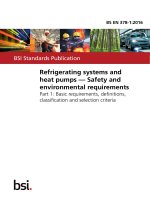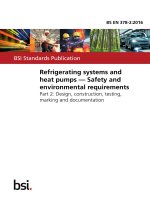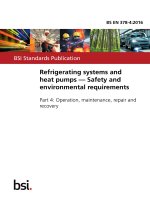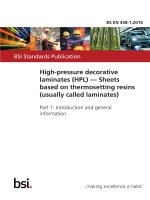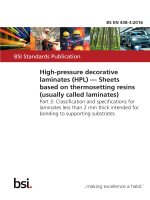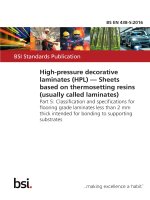Bsi bs en 62052 31 2016
Bạn đang xem bản rút gọn của tài liệu. Xem và tải ngay bản đầy đủ của tài liệu tại đây (4.6 MB, 198 trang )
BS EN 62052-31:2016
BSI Standards Publication
Electricity metering
equipment (AC) — General
requirements, tests and
test conditions
Part 31: Product safety requirements
and tests
BS EN 62052-31:2016 BRITISH STANDARD
National foreword
This British Standard is the UK implementation of EN 62052-31:2016. It is
identical to IEC 62052-31:2015.
The UK participation in its preparation was entrusted to Technical
Committee PEL/13, Electricity Meters.
A list of organizations represented on this committee can be obtained on
request to its secretary.
This publication does not purport to include all the necessary provisions of
a contract. Users are responsible for its correct application.
© The British Standards Institution 2016.
Published by BSI Standards Limited 2016
ISBN 978 0 580 73736 7
ICS 19.080; 91.140.50
Compliance with a British Standard cannot confer immunity from
legal obligations.
This British Standard was published under the authority of the
Standards Policy and Strategy Committee on 30 June 2016.
Amendments/corrigenda issued since publication
Date Text affected
EUROPEAN STANDARD BS EN 62052-31:2016
NORME EUROPÉENNE
EUROPÄISCHE NORM EN 62052-31
ICS 19.080; 91.140.50 June 2016
English Version
Electricity metering equipment (AC) -
General requirements, tests and test conditions -
Part 31: Product safety requirements and tests
(IEC 62052-31:2015)
Equipement de comptage de l'électricité (CA) - Wechselstrom-Elektrizitätszähler -
Exigences générales, essais et conditions d'essai - Allgemeine Anforderungen, Prüfungen und Prüfbedingungen -
Partie 31 : Exigences et essais sur la sécurité de produit
Teil 31: Sicherheitsanforderungen und Prüfungen
(IEC 62052-31:2015) (IEC 62052-31:2015)
This European Standard was approved by CENELEC on 2015-10-20. CENELEC members are bound to comply with the CEN/CENELEC
Internal Regulations which stipulate the conditions for giving this European Standard the status of a national standard without any alteration.
Up-to-date lists and bibliographical references concerning such national standards may be obtained on application to the CEN-CENELEC
Management Centre or to any CENELEC member.
This European Standard exists in three official versions (English, French, German). A version in any other language made by translation
under the responsibility of a CENELEC member into its own language and notified to the CEN-CENELEC Management Centre has the
same status as the official versions.
CENELEC members are the national electrotechnical committees of Austria, Belgium, Bulgaria, Croatia, Cyprus, the Czech Republic,
Denmark, Estonia, Finland, Former Yugoslav Republic of Macedonia, France, Germany, Greece, Hungary, Iceland, Ireland, Italy, Latvia,
Lithuania, Luxembourg, Malta, the Netherlands, Norway, Poland, Portugal, Romania, Slovakia, Slovenia, Spain, Sweden, Switzerland,
Turkey and the United Kingdom.
European Committee for Electrotechnical Standardization
Comité Européen de Normalisation Electrotechnique
Europäisches Komitee für Elektrotechnische Normung
CEN-CENELEC Management Centre: Avenue Marnix 17, B-1000 Brussels
© 2016 CENELEC All rights of exploitation in any form and by any means reserved worldwide for CENELEC Members.
Ref. No. EN 62052-31:2016 E
BS EN 62052-31:2016
EN 62052-31:2016
European foreword
The text of document 13/1639/FDIS, future edition 1 of IEC 62052-31, prepared by IEC/TC 13
"Electrical energy measurement and control" was submitted to the IEC-CENELEC parallel vote and
approved by CENELEC as EN 62052-31:2016.
The following dates are fixed:
• latest date by which the document has to be implemented at (dop) 2016-12-17
national level by publication of an identical national
standard or by endorsement
• latest date by which the national standards conflicting with (dow) 2019-06-17
the document have to be withdrawn
Attention is drawn to the possibility that some of the elements of this document may be the subject of
patent rights. CENELEC [and/or CEN] shall not be held responsible for identifying any or all such
patent rights.
Endorsement notice
The text of the International Standard IEC 62052-31:2015 was approved by CENELEC as a European
Standard without any modification.
In the official version, for Bibliography, the following notes have to be added for the standards indicated:
IEC 60038 NOTE Harmonized as EN 60038.
IEC 60060-1:2010 NOTE Harmonized as EN 60060-1:2010 (not modified).
IEC 60065 NOTE Harmonized as EN 60065.
IEC 60068-1:2013 NOTE Harmonized as EN 60068-1:2014 (not modified).
IEC 60071-1 NOTE Harmonized as EN 60071-1.
IEC 60079-0 NOTE Harmonized as EN 60079-0.
IEC 60228 NOTE Harmonized as EN 60228.
IEC 60255-27:2013 NOTE Harmonized as EN 60255-27:2014 (not modified).
IEC 60269-1 NOTE Harmonized as EN 60269-1.
IEC 60335-1 NOTE Harmonized as EN 60335-1.
IEC 60364-1:2005 NOTE Harmonized as HD 60364-1:2008 (modified).
IEC 60364-4-41 NOTE Harmonized as HD 60364-4-41.
2
IEC 60364-5-52 NOTE BS EN 62052-31:2016
IEC 60664-3:2003 NOTE
Amd 1:2010 EN 62052-31:2016
IEC 60688:2012 NOTE
IEC 60721-3-0:1984 NOTE Harmonized as HD 60364-5-52.
Amd 1:1987 Harmonized as EN 60664-3:2003 (not modified) and
IEC 60721-3-3:1994 NOTE as EN 60664-3:2003/A1:2010 (not modified).
Amd 2:1997 Harmonized as EN 60688:2013 (not modified).
IEC 60947-1:2007, NOTE Harmonized as EN 60721-3-0:1993 (not modified).
Amd 1:2010
Amd 2:2014 NOTE Harmonized as EN 60721-3-3:1995 (not modified) and
IEC 60990 NOTE as EN 60721-3-3:1995/A2:1997 (not modified)
IEC 61008-1 NOTE Harmonized as EN 60947-1:2007 (not modified),
IEC 61000-4-5:2014 NOTE as EN 60947-1:2007/A1:2011 (not modified) and
IEC 61010-1:2010 NOTE as EN 60947-1:2007/A2:2014 (not modified).
IEC 61030-2-030 NOTE Harmonized as EN 60990.
IEC 61140 NOTE Harmonized as EN 61008-1.
IEC 61180-1:1992 NOTE Harmonized as EN 61000-4-5:2014 (not modified).
IEC 61558-1 NOTE Harmonized as EN 61010-1:2010 (not modified).
IEC 61558-2-16 NOTE Harmonized as EN 61030-2-030.
IEC 61643-12 NOTE Harmonized as EN 61140.
IEC 61869-3 NOTE Harmonized as EN 61180-1:1994 (not modified).
IEC 62052-11:2003 NOTE Harmonized as EN 61558-1.
IEC 62052-21:2004 NOTE Harmonized as EN 61558-2-16.
IEC 62053-11:2003 NOTE Harmonized as CLC/TS 61643-12.
IEC 62053-21:2003 NOTE Harmonized as EN 61869-3.
IEC 62053-22:2003 NOTE Harmonized as EN 62052-11:2003 (not modified).
IEC 62053-23:2003 NOTE Harmonized as EN 62052-21:2004 (not modified).
IEC 62053-24:2014 NOTE Harmonized as EN 62053-11:2003 (not modified).
IEC 62053-31:1998 NOTE Harmonized as EN 62053-21:2003 (not modified).
IEC 62054-11:2004 NOTE Harmonized as EN 62053-22:2003 (not modified).
IEC 62054-21:2004 NOTE Harmonized as EN 62053-23:2003 (not modified).
IEC 62055-31:2005 Harmonized as EN 62053-24:2015 (not modified).
Harmonized as EN 62053-31:1998 (not modified).
Harmonized as EN 62054-11:2004 (not modified).
Harmonized as EN 62054-21:2004 (not modified).
Harmonized as EN 62055-31:2005 (not modified).
3
BS EN 62052-31:2016 NOTE Harmonized as EN 62058-11:2010 (modified).
NOTE Harmonized as EN 62058-21:2010 (modified).
EN 62052-31:2016 NOTE Harmonized as EN 62058-31:2010 (modified).
NOTE Harmonized as EN 62477-1:2012 (not modified).
IEC 62058-11:2008 NOTE Harmonized as EN ISO 780.
IEC 62058-21:2008 NOTE Harmonized as EN ISO 7010.
IEC 62058-31:2008
IEC 62477-1:2012
ISO 780
ISO 7010
4
BS EN 62052-31:2016
EN 62052-31:2016
Annex ZA
(normative)
Normative references to international publications
with their corresponding European publications
The following documents, in whole or in part, are normatively referenced in this document and are
indispensable for its application. For dated references, only the edition cited applies. For undated
references, the latest edition of the referenced document (including any amendments) applies.
NOTE 1 When an International Publication has been modified by common modifications, indicated by (mod),
the relevant EN/HD applies.
NOTE 2 Up-to-date information on the latest versions of the European Standards listed in this annex is
available here: www.cenelec.eu.
Publication Year Title EN/HD Year
IEC 60027-1 - EN 60027-1 -
IEC 60068-2-75 2014 Letter symbols to be used in electrical EN 60068-2-75 2014
IEC 60068-2-78 - technology - EN 60068-2-78 -
IEC 60085 - Part 1: General EN 60085 -
IEC 60112 - EN 60112 -
IEC 60269-3 - Environmental testing - HD 60269-3 -
Part 2-75: Tests - Test Eh: Hammer
IEC 60332-1-2 2004 tests EN 60332-1-2 2004
- - + A11 2016 1)
Environmental testing -
Part 2-78: Tests - Test Cab: Damp
heat, steady state
Electrical insulation - Thermal
evaluation and designation
Method for the determination of the
proof and the comparative tracking
indices of solid insulating materials
Low-voltage fuses -
Part 3: Supplementary requirements
for fuses for use by unskilled persons
(fuses mainly for household or similar
applications) - Examples of
standardized systems of fuses A to F
Tests on electric and optical fibre
cables under fire conditions -
Part 1-2: Test for vertical flame
propagation for a single insulated wire
or cable - Procedure for 1 kW pre-
mixed flame
1) To be published.
5
BS EN 62052-31:2016
EN 62052-31:2016
Publication Year Title EN/HD Year
IEC 60332-2-2 2004 EN 60332-2-2 2004
Tests on electric and optical fibre
IEC 60364-4-44 (mod) 2007 cables under fire conditions - HD 60364-4-442 2012
Part 2-2: Test for vertical flame
IEC 60364-4-44 (mod) 2007 propagation for a single small HD 60364-4-444 2010
insulated wire or cable - Procedure for
IEC 60417-DB - diffusion flame - -
IEC 60529 1989 EN 60529 1991
- - Low-voltage electrical installations - + corrigendum May 1993
+ A1 1999 Part 4-442: Protection for safety - + A1 2000
+ A2 2013 Protection of low-voltage installations + A2 2013
IEC 60617-DB - against temporary overvoltages due - -
IEC 60664-1 2007 to earth faults in the high-voltage EN 60664-1 2007
system and due to faults in the low
IEC 60695-2-11 - voltage system EN 60695-2-11 -
IEC 60695-10-2 - Low-voltage electrical installations - EN 60695-10-2 -
IEC 60695-11-10 - Part 4-444: Protection for safety - EN 60695-11-10 -
Protection against voltage
IEC 60950-1 (mod) 2005 disturbances and electromagnetic EN 60950-1 2006
- - disturbances + A11 2009
+ A1 (mod) 2009 + A1 2010
- - Graphical symbols for use on + A12 2011
- - equipment + AC 2011
+ A2 (mod) 2013 + A2 2013
Degrees of protection provided by
enclosures (IP Code)
Graphical symbols for diagrams
Insulation coordination for equipment
within low-voltage systems -
Part 1: Principles, requirements and
tests
Fire hazard testing -
Part 2-11: Glowing/hot-wire based
test methods - Glow-wire flammability
test method for end-products
(GWEPT)
Fire hazard testing -
Part 10-2: Abnormal heat - Ball
pressure test method
Fire hazard testing -
Part 11-10: Test flames - 50 W
horizontal and vertical flame test
methods
Information technology equipment -
Safety -
Part 1: General requirements
6
BS EN 62052-31:2016
EN 62052-31:2016
Publication Year Title EN/HD Year
IEC 61032 1997 EN 61032 1998
IEC 61180-2 - Protection of persons and equipment EN 61180-2 -
IEC 62053-52 - by enclosures - Probes for verification EN 62053-52 -
ISO 75-2 - EN ISO 75-2 -
ISO 306 - High-voltage test techniques for low- EN ISO 306 -
ISO 3864-1 - voltage equipment - - -
Part 2: Test equipment
ISO 7000 2004 - -
Electricity metering equipment (AC) -
Particular requirements -
Part 52: Symbols
Plastics - Determination of
temperature of deflection under load -
Part 2: Plastics and ebonite
Plastics - Thermoplastic materials -
Determination of Vicat softening
temperature (VST)
Graphical symbols - Safety colours
and safety signs -
Part 1: Design principles for safety
signs and safety markings
Graphical symbols for use on
equipment - Index and synopsis
7
– 2 – BS EN 62052-31:2016
IEC 62052-31:2015 © IEC 2015
CONTENTS
FOREW ORD ........................................................................................................................... 8
INTRODUCTION................................................................................................................... 10
1 Scope and object........................................................................................................... 12
1.1 Scope ................................................................................................................... 12
1.2 Object ................................................................................................................... 13
1.2.1 Aspects included in scope ............................................................................. 13
1.2.2 Aspects excluded from scope ........................................................................ 13
1.3 Verification............................................................................................................ 14
1.4 Environmental conditions ...................................................................................... 14
1.4.1 Normal environmental conditions ...................................................................14
1.4.2 Extended environmental conditions ...............................................................14
1.4.3 Extreme environmental conditions .................................................................15
2 Normative references .................................................................................................... 15
3 Terms and definitions .................................................................................................... 16
3.1 Equipment and states of equipment ......................................................................16
3.2 Parts and accessories...........................................................................................17
3.3 Quantities ............................................................................................................. 19
3.4 Tests .................................................................................................................... 21
3.5 Safety terms ......................................................................................................... 21
3.6 Insulation .............................................................................................................. 25
3.7 Terms related to switches of metering equipment..................................................29
4 Tests ............................................................................................................................. 31
4.1 General................................................................................................................. 31
4.2 Type test – sequence of tests ............................................................................... 31
4.3 Reference test conditions...................................................................................... 32
4.3.1 Atmospheric conditions..................................................................................32
4.3.2 State of the equipment...................................................................................32
4.4 Testing in single fault condition .............................................................................36
4.4.1 General ......................................................................................................... 36
4.4.2 Application of fault conditions ........................................................................ 36
4.4.3 Duration of tests ............................................................................................ 38
4.4.4 Conformity after application of fault conditions...............................................38
5 Information and marking requirements ...........................................................................39
5.1 General................................................................................................................. 39
5.2 Labels, signs and signals ...................................................................................... 41
5.2.1 General ......................................................................................................... 41
5.2.2 Durability of markings ....................................................................................43
5.3 Information for selection .......................................................................................43
5.3.1 General ......................................................................................................... 43
5.3.2 General information ....................................................................................... 43
5.3.3 Information related to meters / metering elements .........................................44
5.3.4 Information related to stand-alone tariff-and load control equipment ..............44
5.3.5 Information related to supply control and load control switches......................44
5.4 Information for installation and commissioning ......................................................44
5.4.1 General ......................................................................................................... 44
5.4.2 Handling and mounting .................................................................................. 45
BS EN 62052-31:2016 – 3 –
IEC 62052-31:2015 © IEC 2015
5.4.3 Enclosure ...................................................................................................... 45
5.4.4 Connection .................................................................................................... 45
5.4.5 Protection ...................................................................................................... 47
5.4.6 Auxiliary power supply ...................................................................................48
5.4.7 Supply for external devices............................................................................48
5.4.8 Batteries ........................................................................................................ 48
5.4.9 Self-consumption ........................................................................................... 48
5.4.10 Commissioning .............................................................................................. 49
5.5 Information for use................................................................................................49
5.5.1 General ......................................................................................................... 49
5.5.2 Display, push buttons and other controls ....................................................... 49
5.5.3 Switches ........................................................................................................ 49
5.5.4 Connection to user’s equipment.....................................................................50
5.5.5 External protection devices............................................................................50
5.5.6 Cleaning ........................................................................................................ 50
5.6 Information for maintenance..................................................................................50
6 Protection against electrical shock.................................................................................50
6.1 General requirements ........................................................................................... 50
6.2 Determination of accessible parts .........................................................................51
6.2.1 General ......................................................................................................... 51
6.2.2 Examination................................................................................................... 51
6.2.3 Openings above parts that are hazardous live ...............................................52
6.2.4 Openings for pre-set controls.........................................................................52
6.2.5 Wiring terminals............................................................................................. 53
6.3 Limit values for accessible parts ...........................................................................53
6.3.1 General ......................................................................................................... 53
6.3.2 Levels in normal condition .............................................................................53
6.3.3 Levels in single fault condition ....................................................................... 53
6.4 Primary means of protection (protection against direct contact) ............................56
6.4.1 General ......................................................................................................... 56
6.4.2 Equipment case ............................................................................................. 56
6.4.3 Basic insulation ............................................................................................. 56
6.4.4 Impedance ..................................................................................................... 56
6.5 Additional means of protection in case of single fault conditions (protection
against indirect contact) ........................................................................................ 57
6.5.1 General ......................................................................................................... 57
6.5.2 Protective bonding ......................................................................................... 57
6.5.3 Supplementary insulation and reinforced insulation .......................................61
6.5.4 Protective impedance .................................................................................... 61
6.5.5 Automatic disconnection of the supply ...........................................................61
6.5.6 Current- or voltage-limiting device .................................................................62
6.6 Connection to external circuits .............................................................................. 62
6.6.1 General ......................................................................................................... 62
6.6.2 Terminals for external circuits ........................................................................63
6.6.3 Terminals for stranded conductors .................................................................63
6.7 Insulation requirements.........................................................................................63
6.7.1 General – Electrical stresses, overvoltages and overvoltage categories.........63
6.7.2 The nature of insulation ................................................................................. 64
6.7.3 Insulation requirements for mains-circuits ......................................................68
– 4 – BS EN 62052-31:2016
IEC 62052-31:2015 © IEC 2015
6.7.4 Insulation requirements for non-mains-circuits ...............................................74
6.7.5 Insulation in circuits not addressed in 0 or 6.7.4 ............................................78
6.7.6 Reduction of transient overvoltages by the use of overvoltage limiting
devices .......................................................................................................... 84
6.8 Insulation requirements between circuits and parts ...............................................84
6.9 Constructional requirements for protection against electric shock .........................88
6.9.1 General ......................................................................................................... 88
6.9.2 Insulating materials ....................................................................................... 88
6.9.3 Colour coding ................................................................................................ 88
6.9.4 Equipment case ............................................................................................. 88
6.9.5 Terminal blocks ............................................................................................. 89
6.9.6 Insulating materials of supply control and load switches ................................89
6.9.7 Terminals ...................................................................................................... 90
6.9.8 Requirements for current circuits ...................................................................92
6.10 Safety related electrical tests ................................................................................99
6.10.1 Overview ....................................................................................................... 99
6.10.2 Test methods............................................................................................... 101
6.10.3 Testing of voltage circuits ............................................................................ 104
6.10.4 Dielectric tests ............................................................................................. 106
6.10.5 Electrical tests on current circuits of direct connected meters without
supply control switches (SCSs).................................................................... 112
6.10.6 Electrical tests on current circuits of direct connected meters with SCSs ..... 113
6.10.7 Electrical tests on load control switches (LCSs) ........................................... 119
7 Protection against mechanical hazards ........................................................................ 122
7.1 General............................................................................................................... 122
7.2 Sharp edges ....................................................................................................... 122
7.3 Provisions for lifting and carrying ........................................................................ 123
8 Resistance to mechanical stresses .............................................................................. 123
8.1 General............................................................................................................... 123
8.2 Spring hammer test............................................................................................. 123
9 Protection against spread of fire .................................................................................. 124
9.1 General............................................................................................................... 124
9.2 Eliminating or reducing the sources of ignition within the equipment ................... 125
9.3 Containment of fire within the equipment, should it occur .................................... 125
9.3.1 General ....................................................................................................... 125
9.3.2 Constructional requirements ........................................................................ 126
9.4 Limited-energy circuit.......................................................................................... 126
9.5 Overcurrent protection ........................................................................................ 128
10 Equipment temperature limits and resistance to heat ................................................... 128
10.1 Surface temperature limits for protection against burns ....................................... 128
10.2 Temperature limits for terminals.......................................................................... 129
10.3 Temperatures of internal parts ............................................................................ 130
10.4 Temperature test ................................................................................................ 132
10.5 Resistance to heat .............................................................................................. 133
10.5.1 Non-metallic enclosures .............................................................................. 133
10.5.2 Insulating materials ..................................................................................... 134
11 Protection against penetration of dust and water ......................................................... 134
12 Protection against liberated gases and substances explosion and implosion –
Batteries and battery charging ..................................................................................... 136
BS EN 62052-31:2016 – 5 –
IEC 62052-31:2015 © IEC 2015
13 Components and sub-assemblies ................................................................................ 136
13.1 General............................................................................................................... 136
13.2 Mains transformers tested outside equipment ..................................................... 138
13.3 Printed wiring boards .......................................................................................... 138
13.4 Components bridging insulation .......................................................................... 138
13.5 Circuits or components used as transient overvoltage limiting devices ................ 138
14 Hazards resulting from application – Reasonably foreseeable misuse ......................... 138
15 Risk assessment ......................................................................................................... 139
Annex A (normative) Measuring circuits for touch current .................................................. 140
A.1 Measuring circuit for a.c. with frequencies up to 1 MHz and for d.c. .................... 140
A.2 Measuring circuits for sinusoidal a.c. with frequencies up to 100 Hz and for
d.c. ..................................................................................................................... 141
A.3 Current measuring circuit for electrical burns at high frequencies........................ 141
A.4 Current measuring circuit for wet location ........................................................... 142
Annex B (informative) Examples for insulation between parts ............................................ 143
B.1 Insulation between parts – Example 1 ................................................................. 143
B.2 Insulation between parts – Example 2 ................................................................. 144
B.3 Insulation between parts – Example 3 ................................................................. 145
B.4 Insulation between parts – Example 4 ................................................................. 146
B.5 Insulation between parts – Example 5 ................................................................. 147
Annex C (informative) Examples for direct connected meters equipped with supply
control and load control switches ........................................................................................ 149
Annex D (normative) Test circuit diagram for the test of long term overvoltage
withstand ............................................................................................................................ 151
Annex E (normative) Test circuit diagram for short current test on the current circuit of
direct connected meters...................................................................................................... 152
Annex F (informative) Examples for voltage tests............................................................... 154
Annex G (normative) Additional a.c. voltage tests for electromechanical meters ................ 158
Annex H (normative) Test equipment for cable flexion and pull test ................................... 159
Annex I (informative) Routine tests .................................................................................... 161
I.1 General............................................................................................................... 161
I.2 Protective earth .................................................................................................. 161
I.3 AC power-frequency high-voltage test for mains-circuits ..................................... 161
I.4 Mains-circuits with voltage limiting devices ......................................................... 161
Annex J (informative) Examples of battery protection......................................................... 162
Annex K (informative) Rationale for specifying overvoltage category III ............................. 163
K.1 Transient overvoltage requirements in TC 13 standards ...................................... 163
K.2 Electricity meters mentioned in basic safety publications and group safety
publications ........................................................................................................ 163
K.2.1 IEC 60664-1 ................................................................................................ 163
K.2.2 IEC 60364-4-44 ........................................................................................... 164
K.2.3 IEC 61010-1 ................................................................................................ 164
K.3 Conclusion.......................................................................................................... 165
Annex L (informative) Overview of safety aspects covered................................................. 166
Annex M (informative) Index of defined terms .................................................................... 181
Bibliography........................................................................................................................ 184
– 6 – BS EN 62052-31:2016
IEC 62052-31:2015 © IEC 2015
Figure 1 – Measurements through openings in enclosures ....................................................52
Figure 2 – Maximum duration of short-term accessible voltages in single fault
condition (see 6.3.3 a)) ......................................................................................................... 54
Figure 3 – Capacitance level versus voltage in normal condition and single fault
condition (see 6.3.2 c) and 6.3.3 c))......................................................................................55
Figure 4 – Acceptable arrangements of protection means against electric shock...................57
Figure 5 – Examples of binding screw assemblies ................................................................59
Figure 6 – Distance between conductors on an interface between two layers........................72
Figure 7 – Distance between adjacent conductors along an interface of an inner layer .........72
Figure 8 – Distance between adjacent conductors located between the same two
layers.................................................................................................................................... 74
Figure 9 – Example of recurring peak voltage .......................................................................82
Figure 10 – Flowchart of safety related electrical tests ........................................................ 100
Figure 11 – Flow chart to explain the requirements for protection against the spread of
fire ...................................................................................................................................... 125
Figure 12 – Ball-pressure test apparatus............................................................................. 134
Figure 13 – Flow chart for conformity options 13.1 a), b), c) and d) ..................................... 137
Figure A.1 – Measuring circuit for a.c. with frequencies up to 1 MHz and for d.c. ................ 140
Figure A.2 – Measuring circuits for sinusoidal a.c. with frequencies up to 100 Hz and
for d.c. ................................................................................................................................ 141
Figure A.3 – Current measuring circuit for electrical burns .................................................. 142
Figure A.4 – Current measuring circuit for wet contact ........................................................ 142
Figure B.1 – Insulation between parts – Example 1............................................................. 143
Figure B.2 – Insulation between parts – Example 2............................................................. 144
Figure B.3 – Insulation between parts – Example 3............................................................. 145
Figure B.4 – Insulation between parts – Example 4............................................................. 146
Figure B.5 – Insulation between parts – Example 5............................................................. 147
Figure C.1 – Single phase two wire meter with UC2 SCS and 25A LCS .............................. 149
Figure C.2 – Three phase four wire meter with UC2 SCS and 2A auxiliary control
switch ................................................................................................................................. 150
Figure D.1 – Circuit for three-phase four-wire meters to simulate long term
overvoltage, voltage moved to L3........................................................................................ 151
Figure D.2 – Voltages at the meter under test ..................................................................... 151
Figure E.1 – Test circuit for verification of short-time withstand current test on current
circuits with and without supply control switches ................................................................. 152
Figure E.2 – Example of short-circuit carrying test record in the case of a single-pole
equipment on single-phase a.c. .......................................................................................... 153
Figure F.1 – Test arrangement for voltage tests: 3 phase 4 wire direct connected
meter with supply control and load control switches ............................................................ 154
Figure F.2 – Test arrangement for voltage tests: 3 phase 4 wire transformer connected
meter .................................................................................................................................. 156
Figure H.1 – Test equipment for cable flexion and pull test (see 6.9.7.3) ............................ 159
Figure J.1 – Non-rechargeable battery protection................................................................ 162
Figure J.2 – Rechargeable battery protection...................................................................... 162
BS EN 62052-31:2016 – 7 –
IEC 62052-31:2015 © IEC 2015
Table 1 – Test copper conductors for current and switch terminals .......................................35
Table 2 – Information requirements.......................................................................................40
Table 3 – IEC 60417 symbols and ISO 7000 that may be used on metering equipment ........ 42
Table 4 – Tightening torque for binding screw assemblies ....................................................60
Table 5 – Multiplication factors for clearance for altitudes up to 5 000 m ...............................64
Table 6 – Overview of clauses specifying requirements and tests for insulations ..................67
Table 7 – Nominal / rated voltages and rated impulse voltages .............................................68
Table 8 – Clearances for mains-circuits ................................................................................69
Table 9 – Creepage distances for mains-circuits ...................................................................70
Table 10 – Test voltages for solid insulation in mains-circuits ...............................................71
Table 11 – Test voltages for testing long-term stress of solid insulation in mains-
circuits .................................................................................................................................. 71
Table 12 – Minimum values for distance or thickness of solid insulation................................73
Table 13 – Clearances and test voltages for non-mains-circuits derived from mains-
circuits of overvoltage category III ........................................................................................75
Table 14 – Creepage distances for non-mains-circuits ..........................................................75
Table 15 – Minimum values for distance or thickness (see 6.7.4.4.2 to 6.7.4.4.4) ................77
Table 16 – Clearance values for the calculation of 6.7.5.2 ....................................................80
Table 17 – Test voltages based on clearances......................................................................81
Table 18 – Clearances for basic insulation in circuits having recurring peak voltages ..........83
Table 19 – Isolation classes for non-mains-circuits ...............................................................85
Table 20 – Insulation requirements between any two circuits ................................................86
Table 21 – Summary of requirements for current circuits of direct connected meters
without SCS .......................................................................................................................... 95
Table 22 – Summary of requirements for current circuits of direct connected meters
with SCS............................................................................................................................... 96
Table 23 – Summary of requirements for load control switches .............................................98
Table 24 – Correction factors according to test site altitude for test voltages for
clearances .......................................................................................................................... 104
Table 25 – AC voltage test.................................................................................................. 109
Table 26 – Test sequence and sample plan for supply control switches .............................. 113
Table 27 – Power factor ranges of the test circuit ............................................................... 116
Table 28 – Test sequence and sample plan for load control switches.................................. 120
Table 29 – Limits of maximum available current .................................................................. 127
Table 30 – Values for overcurrent protection devices .......................................................... 127
Table 31 – Surface temperature limits in normal condition .................................................. 129
Table 32 – Temperature limits for terminals ........................................................................ 130
Table 33 – Maximum measured total temperatures for internal materials and
components ........................................................................................................................ 131
Table G.1 – AC voltage tests of electromechanical meters.................................................. 158
Table H.1 – Test values for flexion and pull-out tests for round copper conductors ............. 160
Table L.1 – Overview of safety aspects ............................................................................... 166
– 8 – BS EN 62052-31:2016
IEC 62052-31:2015 © IEC 2015
INTERNATIONAL ELECTROTECHNICAL COMMISSION
____________
ELECTRICITY METERING EQUIPMENT (AC) –
GENERAL REQUIREMENTS, TESTS AND TEST CONDITIONS –
Part 31: Product safety requirements and tests
FOREWORD
1) The International Electrotechnical Commission (IEC) is a worldwide organization for standardization comprising
all national electrotechnical committees (IEC National Committees). The object of IEC is to promote
international co-operation on all questions concerning standardization in the electrical and electronic fields. To
this end and in addition to other activities, IEC publishes International Standards, Technical Specifications,
Technical Reports, Publicly Available Specifications (PAS) and Guides (hereafter referred to as “IEC
Publication(s)”). Their preparation is entrusted to technical committees; any IEC National Committee interested
in the subject dealt with may participate in this preparatory work. International, governmental and non-
governmental organizations liaising with the IEC also participate in this preparation. IEC collaborates closely
with the International Organization for Standardization (ISO) in accordance with conditions determined by
agreement between the two organizations.
2) The formal decisions or agreements of IEC on technical matters express, as nearly as possible, an international
consensus of opinion on the relevant subjects since each technical committee has representation from all
interested IEC National Committees.
3) IEC Publications have the form of recommendations for international use and are accepted by IEC National
Committees in that sense. While all reasonable efforts are made to ensure that the technical content of IEC
Publications is accurate, IEC cannot be held responsible for the way in which they are used or for any
misinterpretation by any end user.
4) In order to promote international uniformity, IEC National Committees undertake to apply IEC Publications
transparently to the maximum extent possible in their national and regional publications. Any divergence
between any IEC Publication and the corresponding national or regional publication shall be clearly indicated in
the latter.
5) IEC itself does not provide any attestation of conformity. Independent certification bodies provide conformity
assessment services and, in some areas, access to IEC marks of conformity. IEC is not responsible for any
services carried out by independent certification bodies.
6) All users should ensure that they have the latest edition of this publication.
7) No liability shall attach to IEC or its directors, employees, servants or agents including individual experts and
members of its technical committees and IEC National Committees for any personal injury, property damage or
other damage of any nature whatsoever, whether direct or indirect, or for costs (including legal fees) and
expenses arising out of the publication, use of, or reliance upon, this IEC Publication or any other IEC
Publications.
8) Attention is drawn to the Normative references cited in this publication. Use of the referenced publications is
indispensable for the correct application of this publication.
9) Attention is drawn to the possibility that some of the elements of this IEC Publication may be the subject of
patent rights. IEC shall not be held responsible for identifying any or all such patent rights.
International Standard IEC 62052-31 has been prepared by IEC technical committee 13:
Electrical energy measurement and control.
The text of this standard is based on the following documents:
FDIS Report on voting
13/1639/FDIS 13/1645/RVD
Full information on the voting for the approval of this standard can be found in the report on
voting indicated in the above table.
This publication has been drafted in accordance with the ISO/IEC Directives, Part 2.
BS EN 62052-31:2016 – 9 –
IEC 62052-31:2015 © IEC 2015
A list of all parts of IEC 62052 series, under the general title Electricity metering equipment
(AC) – General requirements, tests and test conditions, can be found on the IEC website.
In this standard, the following print types are used:
• requirements and definitions: in roman type;
• NOTES: in smaller roman type;
• conformity and tests: in italic type.
The committee has decided that the contents of this publication will remain unchanged until
the stability date indicated on the IEC web site under "" in the data
related to the specific publication. At this date, the publication will be
• reconfirmed,
• withdrawn,
• replaced by a revised edition, or
• amended.
A bilingual version of this publication may be issued at a later date.
IMPORTANT – The 'colour inside' logo on the cover page of this publication indicates
that it contains colours which are considered to be useful for the correct
understanding of its contents. Users should therefore print this document using a
colour printer.
– 10 – BS EN 62052-31:2016
IEC 62052-31:2015 © IEC 2015
INTRODUCTION
NOTE 1 The following text is based on IEC Guide 104, ISO/IEC Guide 51 and IEC 60255-27:2013.
The IEC addresses safety aspects by establishing basic, group and product safety
publications.
A basic safety publication covers a specific safety-related matter, applicable to many
electrotechnical products. It is primarily intended for use by technical committees in the
preparation of standards in accordance with the principles laid down in IEC Guide 104 and
ISO/IEC Guide 51. It is not intended for use by manufacturers or certification bodies. One of
the responsibilities of a technical committee is, wherever applicable, to make use of basic
safety publications in the preparation of its publications. The requirements, test methods or
test conditions of basic safety publications will not apply unless specifically referred to or
included in the relevant publications.
A group safety publication covers all safety aspects of a specific group of products within the
scope of two or more product TCs. Group safety publications are primarily intended to be
stand-alone product safety publications, but may also be used by TCs as source material in
the preparation of their publications.
A product safety publication covers all safety aspects of one or more products within the
scope of a single product TC.
Existing product standards established by TC 13 include a range of safety requirements, test
methods and test conditions. However, an important requirement of IEC Guide 104:2010,
5.2.3 has not been met so far:
“Safety aspects and performance aspects should not be covered in the same publication,
as this makes it difficult to assess conformity with safety requirements alone. If,
exceptionally, there are reasons to cover them in the same publication, safety aspects and
performance aspects shall be clearly distinguished from each other. If there are
performance criteria which have safety implications, these are considered to be safety
aspects and this shall be made clear in the publication.”
In addition, some important aspects of product safety, such as safety under single fault
conditions, have not been covered so far.
The objectives of the development of this International Standard are the following:
• to specifically reference and include relevant requirements, test methods or test conditions
of relevant basic safety publications so that they become applicable;
• to specifically reference and include – where appropriate, in a modified form – relevant
requirements, test methods or test conditions of relevant group safety publications;
• to consider the latest developments in the technology used for the design and
manufacture of equipment for electrical energy measurement and control;
• to remove any ambiguity resulting from the lack of a comprehensive product safety
standard for products in the Scope of TC 13;
• to achieve a uniform approach to product safety throughout the international metering
industry.
This product safety standard is based on, among others, the following:
• the basic safety standard IEC 60664-1:2007, established by TC 109;
• standards from the IEC 60364 series related to electrical installations of buildings,
established by TC 64;
• the group safety standard IEC 61010-1:2010 established by TC 66;
BS EN 62052-31:2016 11
IEC 62052-31:2015 â IEC 2015
ã the group safety standard IEC 62477-1:2012 established by TC 22;
• IEC 60255-27:2013, a product safety standard for measuring relays and protection
equipment, established by TC 95. These products are similar in their design and to some
extent in their use in equipment for electrical energy measurement and control,
To facilitate the use of this standard, an integral text has been prepared, with appropriate 539
references to source documents.
This standard cancels and replaces the safety requirements specified in earlier standards
established by IEC TC 13. See also Annex L (Informative).
NOTE 2 When this standard is published, an amendment to the relevant standards affected by this standard in
IEC 62052, IEC 62053 and IEC 62054 will be published, to indicate which parts of those standards are replaced /
cancelled by this standard.
Being a product safety standard, this standard takes precedence over the group safety
standards IEC 61010-1:2010 and IEC 62477-1:2012.
– 12 – BS EN 62052-31:2016
IEC 62052-31:2015 © IEC 2015
ELECTRICITY METERING EQUIPMENT (AC) –
GENERAL REQUIREMENTS, TESTS AND TEST CONDITIONS –
Part 31: Product safety requirements and tests
1 Scope and object
1.1 Scope
This part of IEC 62052 specifies product safety requirements for equipment for electrical
energy measurement and control.
NOTE 1 For other requirements, see the relevant standards.
This International Standard applies to newly manufactured metering equipment designed to
measure and control electrical energy on 50 Hz or 60 Hz networks with a voltage up to 600 V,
where all functional elements, including add-on modules are enclosed in or form a single
case.
NOTE 2 The voltage mentioned above is the voltage line-to-neutral derived from nominal voltages. See Table 7.
This International Standard also applies to metering equipment containing supply and load
control switches, but only those which are electromechanical in operation.
NOTE 3 For components and sub-assemblies, see Clause 13.
When such equipment is designed to be installed in a specified matching socket, then the
requirements apply to, and the tests shall be performed on, equipment installed in its
specified matching socket. However, requirements for sockets and inserting / removing the
meters from the socket are outside the scope of this standard.
This International Standard is also applicable to auxiliary input and output circuits.
NOTE 4 Examples are impulse inputs and outputs, control inputs and outputs, circuits for meter data exchange.
In this standard distinction is made between:
• electromechanical meters, static meters and equipment for tariff and load control;
• direct connected, current transformer operated, voltage and current transformer operated
meters;
• protective class I and protective class II equipment;
• wall or cabinet mounted, rack mounted and panel mounted equipment;
• equipment intended for indoor use and outdoor use.
Equipment used in conjunction with equipment for electrical energy measurement and control
may need to comply with additional safety requirements. See also Clause 13.
NOTE 5 Examples are telecommunication modems and customer information units.
This International Standard does not apply to:
• equipment where the voltage line-to-neutral derived from nominal voltages exceeds 600 V;
• portable meters;
NOTE 6 Portable meters are meters that are not permanently connected.

